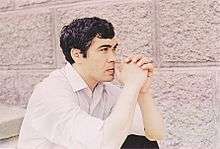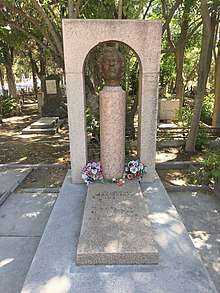Nury Halmammedov
| Nury Halmammedov | |
|---|---|
 | |
| Background information | |
| Birth name | Nurmamed Halmamedov |
| Born |
20 June 1938 Daýna village, Kara-Kalinsk district, Turkmen SSR |
| Died |
4 August 1983 (aged 45) Ashgabat, Turkmen SSR |
| Genres | classical |
| Occupation(s) | Composer |
| Instruments | Pianoforte |
| Years active | 1956-1983 |
Nury Halmammedov (Turkmen: Nury Halmämmedow, also Nury Halmämmet, Russian: Нуры Халмамедов) (20 June 1938 – 4 August 1983)[1][2] was a prominent Turkmen composer described as one of Turkmenistan's "greatest sons".[3] His legacy has been commemorated with anniversary events in Turkmenistan and Russia.[4][5][6][7]
Early childhood and education
Nury Halmammedov was born on 20 June 1938 in Daýna village near Baherden, Turkmenistan, to Halmämed Baýlyew and Hangül-Eje Mamedaliýewa.[2][5][8] He had a very difficult childhood. According to Jemile Gurbanowa's biography of Halmamedov, his mother died in 1944, and his father moved to Iran with two of the family's four sons, Begmamed and Ashyrberdi, abandoning Nury, his 17-year-old brother, Bayly, and older sister, Artyk. Nury's memories of this time were grim; he recounted at one point,
- Since in my childhood I drank cloudy water from an irrigation ditch and lived off the grasses growing along its banks, by age 4 or 5 my belly swelled up and was elastic, like a ball. Because of my round stomach I couldn't see my own feet.[9]
Bayly committed Nury to the Karakalinsk orphanage. In 1947 Nury was transferred to the Baherden boarding school. At some point, however, around 1950 or 1951 little Nury ran away from the boarding school, stowed away on a freight train, and ended up in Ashgabat. When discovered by authorities, since he had no papers and could not identify his parents, he was sent to the Baýramaly orphanage. Here he encountered a piano teacher, Olga Krivchenko, and began studying piano.[2][10]
After three and a half years, in 1954, Halmammedov was transferred to Turkmen State Music School in Ashgabat, where he studied under Viktor Khiruntsev and Elena Kulesh. At this school he was introduced to composition by Ashir Kuliyev, and wrote his first piece, "Dance", for piano. Other compositions during this period include "March", "Play", and "Reminisces", as well as pieces for cello and violin with piano.[2][11]
In 1958 he entered Moscow State P. I. Tchaikovsky Conservatory, graduating in 1963.[3][10] His major adviser was Anatoly Alexandrov, who described Halmammedov as "...devilishly talented..." and "a gifted rarity".[11] While at the conservatory Halmammedov wrote about 30 songs, romances, and choral works, including romances based on the works of Magtymguly Pyragy and Mollanepes. His graduation project was the symphonic portrait "Turkmenia", which premiered at his graduation examination in 1963, performed by the All-Union Radio and Television Great Symphony Orchestra. It was his first symphonic composition.[2]
Career
Halmammedov published at least 175 works between 1956 and his death in 1983. These included musical scores for 30 motion pictures, including 9 animated films, 18 art films, and 3 documentaries.[12][13] The first of these scores was for Bulat Masurov's 1963 film, Contest. The score for Alty Garlyev's Decisive Step followed in 1965. Halmammedov additionally put verse to music, including poetry by Gurbannazar Ezizov, as well as Sergey Esenin and Heinrich Heine. He composed the music for the 1974 opera Görogly.[2] Halmammedov wrote over 40 works for pianoforte. He wrote the libretto and score for the 1983 ballet version of Decisive Step, which was performed at the Magtymguly Theater in Ashgabat.[14]
Halmammedov died in Ashgabat of cirrhosis of the liver and complications of diabetes.[15] He is buried at the Vatutin Cemetery there.

A street in Ashgabat is named in Halmammedov's honor, and a statue of him stands at western end of that street.[16]
Musical Style
Aleksandrov told Halmammedov when handing him his diploma upon graduation from the conservatory that he should continue to study Turkmen folk music but also should listen as often as possible to other music. In Çerkezowa's words, Halmammedov took this advice and learned he could "find points of contact" between two completely different genres and "harmonically merging two miracles, he created a third."[11]
Halmammedov's work was noted for incorporating elements from both the Turkmen folk musical heritage and the broader classical tradition as taught at the Moscow conservatory.[17] Turkmen singer Medeniýet Şahberdiýewa, who performed many of his works, remarked, "The rhythms of Nury's works are Turkmen, but the harmony belongs to world musical culture."[18]
Vasiliy Larionov noted that Halmammedov's Persian Motifs applied a plot progression characteristic of Turkmen folk dessans: "The action is interpreted in a generalized emotional manner, action is shaped less by the progression of events than by their internal psychological interaction."[14]
Musicologist Jemile Gurbanowa noted the influences of early Franz Schubert on Halmammedov's vocal works, of Nikolai Rimsky-Korsakov and Aram Khachaturian on his symphonic works, of Robert Schumann on piano pieces, and of Franz Liszt and Sergei Rachmaninoff on romantic works. She noted as well, however, that national folklore remained his "primary inspiration."[19] Çerkezowa cites film producer Yevgeny Mikhelson's description of Halmammedov's score for one of his animated features, "...the national tone...which ran like a red thread through his entire composition."[20]
Personal Life
Halmammedov was married twice. He had three children by his first wife, sons Röwşen and Sapar, and daughter Leýli. His second wife and widow is Gülsoltan Klychevna Halmammedova (Russian: Гульсолтан Клычевна Халмамедова), who for many years headed Turkmenfilm. They have a son, Aşyrberdi.
Awards
- 1979 Meritorious Arts Activist of Turkmenistan
- 1983 Turkmenistan State Magtymguly Prize (posthumously)
- 1984 USSR State Prize (posthumously)
- 1991 People's Artist of Turkmenistan (posthumously)[2]
Discography
- Turkmenia Suite (сюита "Туркмения"), Melodiya, 1967[12]
- Turkmenia Suite (сюита "Туркмения"), Sovetskiy kompozitor, 1968[12]
- Tuýduk (Туйдук), 1981, C30-16287[14]
- Symphony in E-minor (Симфония: ми-минор), 1983, M10 46181 008[14]
- Interrupted Songs of Children of Hiroshima and Nagasaki (Недослушанные пести детей Хиросимы и Нагасаки), 1983, C 10 21689 003[14]
- Quartet for Two Violins, Viola, and Cello (Кватет для 2-х скрипок, альта, виолончели), 1985, C 10 23097 001[14]
- Plays for Pianoforte (Пьесы для фортепиано), undated, C 10 23403 007[14]
- To You (К тебе), 1984, C 1022353 009[14]
- Songs of Nury Halmammedov (Песни Нуры Халмаммедова), 1980-1985, C 60 28203 008[14]
- Ashgabat (Ашгабат), undated, 60-13215[14]
- Spring (Бахар), undated, D 00023193[14]
- Two Trees (Два дерева), 1975-1986, C 60 27897002[14]
- Enchantment (Очарование, Хайрана галар), 1984, C 60 23017 004[14]
- Artyk's Song from the Motion Picture 'Decisive Step' (Песня Артыка из кинофильма "Решающий шаг"), undated, D 23151[14]
- Saňa garaşýan, undated, M 61 36368[14]
- Heart of the Poet (Сердце поэта, Şahyr ýüregi, 1980-1985, C 60 2803 008[14]
- Song About Lenin (Lenin hakynda aýdym), undated, C 30 09001[14]
- Ballad of Fate (Keçpelek, Баллада о судьбе), 1980, C 60-14789-90[14]
External Links to Music
- Nury Halmamedov (YouTube)
- Nurı Xalməmmədov - Qaraqum çölü (Nury Halmammedov - Kerwen) (YouTube)
- Нуры Халмамедов музыка из к/ф "Шукур Бахши" (Nury Halmammedov, music from Shukur Bakhshi, performed by Mamed Guseynov) (YouTube)
- The Interrupted songs of children of Hiroshima and Nagasaki (performed by Mamed Guseynov) (YouTube)
References
- ↑ Kamev, Andre (2005). Le Turkménistan. KARTHALA. p. 150. ISBN 2-84586-632-1.
- 1 2 3 4 5 6 7 Gurbanowa, Jemile (2014). Nury Halmämmet. Ylym.
- 1 2 Najibullah, Farangis (24 February 2010). "Turkmenistan (Fails To) Mark Greatest Musical Son's 70th Birthday". Radio Free Europe/Radio Liberty.
- ↑ Achilov, Agajan (December 2007). "Let My Music Talk For Me". Government of Turkmenistan.
- 1 2 Çerkezowa, Parahat (2013). Nury Halmämmedow. Ylym. p. 38.
- ↑ Первый Московский международный фестиваль туркменской классической музыки "Звуки дутара" имени Нуры Халмамедова, 31 марта 2015
- ↑ СРОКИ ПРОВЕДЕНИЯ II ФЕСТИВАЛЯ
- ↑ Gurbanowa and Çerkezowa put Halmammedov's birth date as June 20, 1938, based on an original birth certificate discovered, in Çerkezowa's words, "not long ago", and which is reproduced on page 38 of her book. According to this birth certificate, his given name at birth was Nurmamed (Russian: Нурмамед). His grave marker in Vatutin Cemetery, Ashgabat, erroneously lists his birth date as 24.II.1940, or February 24, 1940, based on an estimate made by officials at the Baýramaly orphanage, who issued him a substitute birth certificate, as they did not know where he was born. Mistaken references to November 24, 1940, appear to confuse the Roman numerals II (2, for the second month, February) with the Arabic numerals 11.
- ↑ Çerkezowa, Parahat (2013). Nury Halmämmedow. Ylym. p. 109.
- 1 2 Çerkezowa, Parahat (2013). Nury Halmämmedow. Ylym. p. 130.
- 1 2 3 Çerkezowa, Parahat (2013). Nury Halmämmedow. Ylym. p. 106.
- 1 2 3 Жавроников, Б.; Ларионов, В. (1982). Композиторы и музыковеды Туркменистана. Ashgabat: Издательство "Туркменистан". p. 272.
- ↑ Çerkezowa, Parahat (2013). Nury Halmämmedow. Ylym. p. 111.
- 1 2 3 4 5 6 7 8 9 10 11 12 13 14 15 16 17 18 Ларионов, Василий (1995). Композитор Нуры Халмәммедов. Ashgabat: Дамана. p. 72.
- ↑ Çerkezowa, Parahat (2013). Nury Halmämmedow. Ylym. p. 112.
- ↑ "Mapillary photo of Nury Halmammedov statue in Ashgabat".
- ↑ Brummell, Paul (2006). Turkmenistan: the Bradt travel guide. Bradt Travel Guides. p. 54. ISBN 1-84162-144-7.
- ↑ Çerkezowa, Parahat (2013). Nury Halmämmedow. Ylym. p. 99.
- ↑ Çerkezowa, Parahat (2013). Nury Halmämmedow. Ylym. p. 107.
- ↑ Çerkezowa, Parahat (2013). Nury Halmämmedow. Ylym. p. 108.